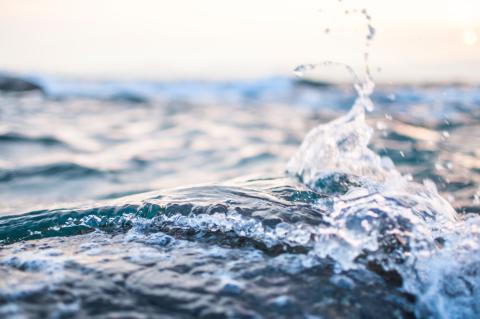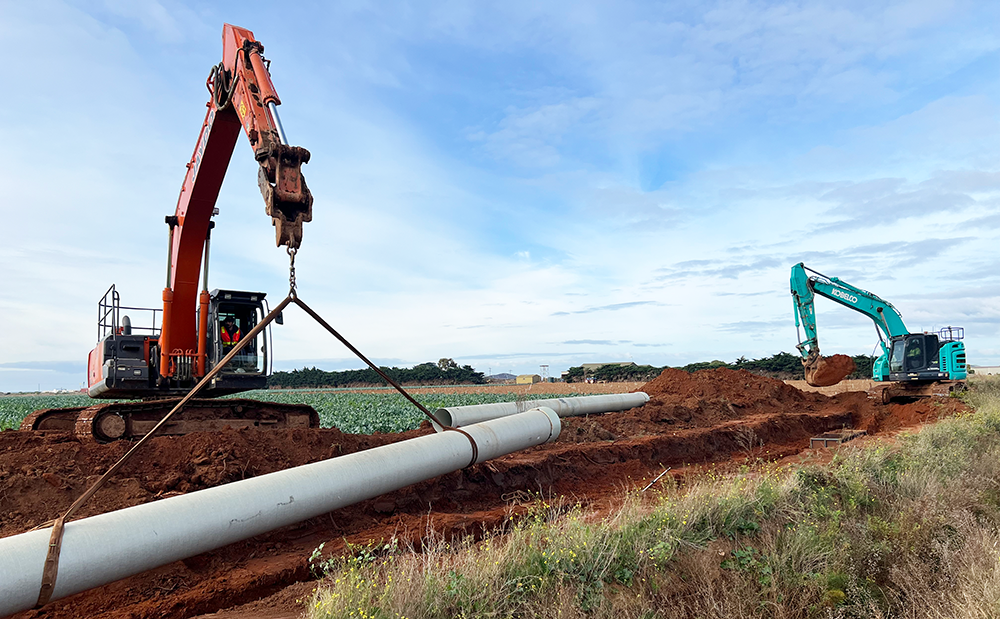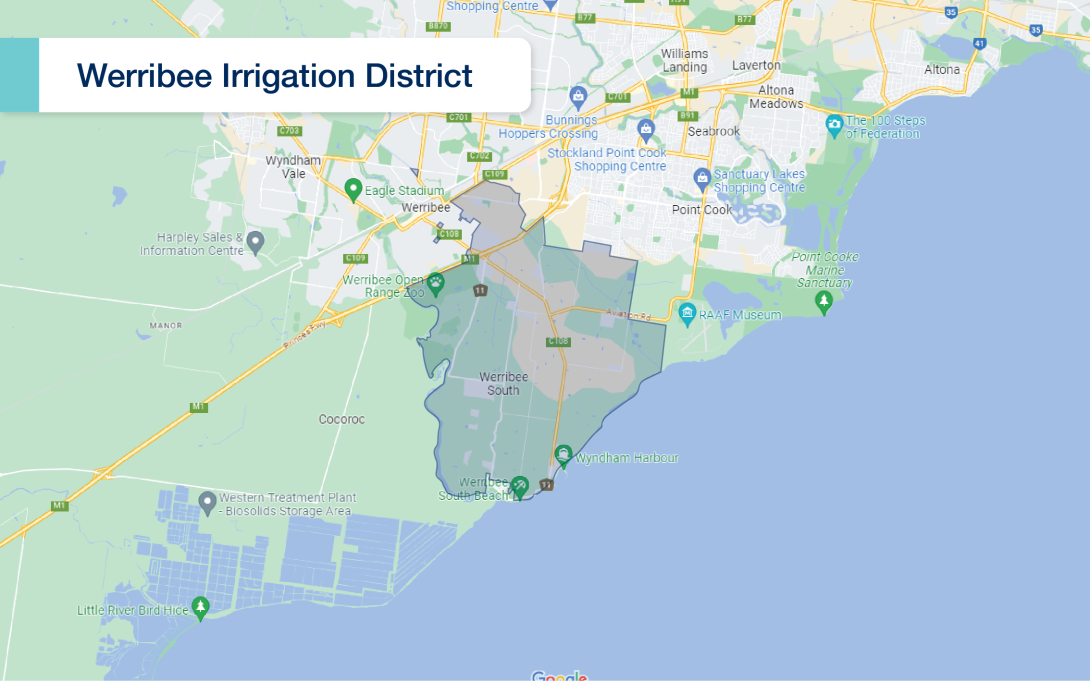The Werribee Irrigation District is a major agricultural area, located in Werribee, Victoria, approximately 30–40 km southwest of Melbourne.
It is one of the state’s key food-producing regions, particularly known for growing vegetables such as lettuce, broccoli, cauliflower, and celery.
The district covers about 3,000 hectares of farmland, with farming business supplying fresh produce to Melbourne’s markets and supermarkets.
The district primarily sources water from the Werribee River, Pykes Creek Reservoir, and Melton Reservoir, with some use of recycled water from the Western Treatment Plant.

Order water over the phone or online using Waterline. Head to our water ordering page to find out more.
Electrical Conductivity (salinity) Werribee River
Electrical conductivity (ec) is measured in microsiemens per centimeter (µS/cm)
-
History
Settlement of the Werribee Basin quickly followed the arrival of John Batman in 1835. By 1837 squatters had reached the Bacchus Marsh area and by 1840 most of the plains and foothills within the river basin were occupied.
The Werribee Irrigation Trust was formed in November 1888 following demands for alternative water supplies to avoid the consequences of severe droughts. It was to provide irrigation facilities for 595 hectares of land north of the Melbourne-Geelong railway line, adjacent to the township of Werribee. The Trust operated for only a few years before it failed financially. It was eventually abolished under the provisions of the Water Act of 1905.
In March 1906, the State Government’s Land Purchase and Management Board purchased 9,400 ha of the “Werribee Estate” to develop as an irrigation area and subdivide for closer settlement. Of this, 3,400 ha were later assessed as suitable for irrigation.
The Pykes Creek Reservoir, which was the initial storage for both the Werribee Irrigation District and the irrigation system upstream at Bacchus Marsh, was completed in 1911. The diversion weir on the Werribee River and the main channel of the irrigation district were completed in 1912 and a system of channels was constructed to supply water for domestic and stock purposes to non-irrigated areas within the old estate and for irrigation of around 265 hectares of land.
By 1914 the area of land that could be irrigated had been increased to 2,185 hectares. In 1916, Melton Reservoir was completed. Following this and the completion of other works, the Werribee Irrigation and Water Supply District was formed in October 1917 under the control of the State Rivers and Water Supply Commission.
Construction of a surface drainage system began in 1920 for areas with poor sub-soils. The drainage system has since been extended and now serves nearly all the irrigation district and some land outside of it.
The final stage in the Werribee Basin storage system was put in place with the construction of Merrimu Reservoir in 1969-1986.
-
Modernisation

The Werribee Irrigation District modernisation project began in 2016 and was completed in 2024,
The $42 million project was delivered in five stages and replaced the region’s ageing and inefficient channel irrigation network with over 39 kilometres of new modern pipeline and 208 automated customer outlets.
Stages 1 to 3 were completed in 2019 and delivered 23 kilometres of pipeline and 138 upgraded customer outlets.
Stage 4 was completed in December 2023 and involved construction of 7.9 kilometres of pipeline in the vicinity of Hoppers Lane south to Aviation Road, and an additional 340 meters of pipeline adjacent to Aviation Road.
Stage 5 was completed in October 2024 and delivered 8.3 kilometres of new pipeline and a new regulator inside the Tarneit Street irrigation channel.
Seventy customer outlets were automated as part of Stage 4 and Stage 5 works that has enabled more reliable water delivery, better service to customers, and more accurate meter reads.
Modernisation in Werribee has generated approximately 5,000 megalitres of water savings across all five stages. This will be used to enhance local irrigation and the health of the Werribee River.
This once-in-a-generation infrastructure investment has been vital in future-proofing the district supporting farmers to be more climate resilient and enabling them to continue to produce food in a hotter, drier future. .
Werribee Irrigation District modernisation was jointly funded by Southern Rural Water, the Victorian Government and the Australian Government through the National Water Grid Fund.
-
Operations
The WID now receives its irrigation supply from the combination of three storages at Pykes Creek, Merrimu Reservoir and Melton Reservoir. These storages now hold water from both the Werribee and Lerderderg River systems.
Following several years of extreme drought conditions, the WID Recycled Water Scheme was implemented in 2004 to supplement water supply.
Although a great deal of pipe-lining has been carried out as a result of urban development and the replacement of channels, much of the district remains open channel, including significant lengths of the main channel from the Werribee River.
Like Bacchus Marsh and the Macalister Irrigation District in Gippsland, Werribee is a gravity irrigation district and relies on upstream heads of water to move supply through the channels and pipes to the customer.
Water is ordered by customers through Southern Rural Water’s Waterline ordering system and delivered by our Water Services Officers through a complex series of checks, regulators and valves. This brings the water to the “farm gate”, where it is measured by a Dethridge wheel on open channels or a standard flow meter on pipelines. From here it is directed by the customer, usually into storage dams and then into on-farm irrigation systems.
Prices for water in the Werribee Irrigation District are determined by the Essential Services Commission following recommendation by the Southern Rural Water Board. This recommendation is made following consultation with the Werribee Bacchus Marsh Customer Consultative Committee, which is made up of customers from within the district.
-
Werribee winter irrigation roster
To enable our customers to plan winter irrigation requirements in conjunction with Southern Rural Water’s winter maintenance activities, please note the Werribee winter irrigation roster from May to the end of September.
Providing there is enough demand, water supply will be available to irrigators in the Werribee Irrigation District from Monday to Friday \ during the season.
*Note: Recycled water availability is subject to scheduled annual maintenance by Melbourne Water.
In exceptional circumstances if demand is high, we may deliver water on non-rostered days. Please place your order on Waterline at www.srw.com.au/worder/ or contact the 24-hour telephone Water Ordering Service on 1300 360 117. You will need to place your orders at least one business day before the water is required.
-
Private works
If you want to do works around (near, on or over) infrastructure controlled by Southern Rural Water, including open channels, pipelines and drains, you will need a licence to construct and use private works.
These structures can include:
- Occupational crossings
- Siphons
- New or replacement outlets
- Power or water lines
- Pivot crossings
- Or any other structures
How do I apply for a licence?
- Contact our Land Management Coordinator to discuss your plan. This will include an on-site meeting.
- Submit an application form: Request for the Approval of Private Works (no payment is needed up front)
- If approved, we will send you a written agreement with a request for fees for you to sign and send back with payment
- Once we have received this and approved the agreement, works can start
- During the project, our Land Management Coordinator will inspect regularly to check progress and that you are complying with specifications.
Security deposit
Part of the fee is a security deposit, which we will refund when the project is completed to the required standard and specifications.
Compliance
Please note that failure to comply with our processes and requirements is a breach of Section 148 of the Water Act 1989, and could result in prosecution.
-
Location
The Werribee Irrigation District (WID) is one of Melbourne’s vegetable “gardens”, located on Melbourne’s doorstep in the estuarine flood plain of the Werribee River.
The region was settled immediately after the first arrivals in Melbourne of European settlers, and has been an important agricultural centre since the early 19th century.

Related pages
Click on these related pages to discover more about our Modernisation project, find related application forms and the current WID Allocations.

